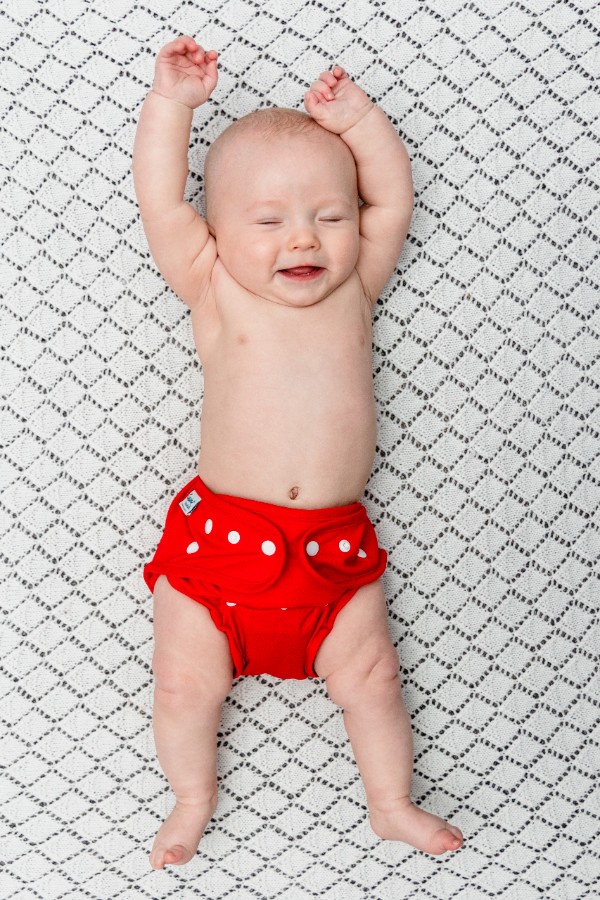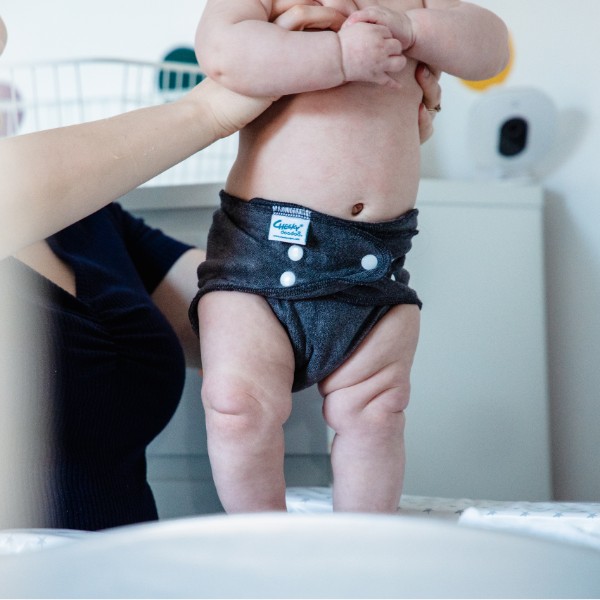The Beginnerís Guide to Reusable Nappies11 October 2022 | Admin If you're expecting a baby choosing between disposable and reusable nappies can seem tricky. On one hand, you want to be eco-friendly but you also want life to be easy. After all you're going to have a small baby to look after and aren't sure if you'll be able to cope with washing cloth nappies. At Team Cheeky, we've been there and done that and ended up using washable nappies for all 4 children from birth to potty training. Even if you only use cloth nappies part time, overnight for example, it's worthwhile considering reusables. 
If you're trying to make that decision, here's our beginners guide to reusable nappies. It covers everything you need to know about making the switch to reusable nappies — and why it’s the best decision we made. Reusable nappies are simply nappies made from absorbent material, covered with a waterproof outer layer, which can be used, washed and reused. They are generally made from cotton, cotton hemp or bamboo. At the most basic level, reusable nappies can be formed of squares of cloth which is folded within a water resistant wrap usually made from polyurethane laminate (PUL). The absorbent cloth layer can be thin cotton muslin, or thicker cotton or bamboo terry material. Muslin squares are a great idea when your baby is newborn. They can be used with a 'one size fits most' nappy cover which can then be used with fitted nappies as your baby grows. You may have heard of 'terry squares' which in decades gone by were fitted with a large nappy pin! 
These days 'nappy nippas' have replaced nappy pins and the cloth squares themselves can be folded in many ways to suit your baby. For example, little boy babies tend to pee more at the front, so the cloth squares can be folded with more absorbency at the front. Little girls pee out the bottom of the nappy, so again, the squares can be folded with extra absorbency underneath. Some reusable nappies look very similar to disposable nappies in that they are made from one piece with velcro straps or poppers to close. Although these are pretty simple to use, from experience, it's difficult to get the fit correct which can lead to leaks. Pocket nappies are another popular type of nappy, with an outer waterproof wrap which contains a pocket which can be stuffed with a fabric absorbent inner. These tend to be a cost effective solution. From experience, 2 part nappies tend to be pretty poonami proof. Our Cheeky Bamboo cloth nappies were designed and tested by more than 100 parents. They're formed of a slim fitted bamboo fabric nappy and a one size fits most nappy cover. Because they're made from bamboo, they're super absorbent so they make a fantastic night nappy. Cheeky Doodoo nappies are charcoal coloured too. This means that it's easy to see when your baby has a wet nappy and needs changing which can be tricky with white nappies. Also, nappies, tend to be the most soiled item you'll ever have to wash...why on earth would you make them white? 
No matter which type of reusable nappy you choose, they all work in the same way: - Stay dry nappy liner to wick away wetness
- Absorbent layer to trap moisture
- Waterproof layer to prevent leaks
The stay dry layer against your baby's skin wicks away wetness and generally poo will stick to this layer for easy disposal. In most cases fleece liners are recommended because they allow your baby to feel dry and comfortable, however poo comes off easily. The absorbent layer can be made from any sort of cloth material. Generally cotton or bamboo are the most popular materials, although some companies use microfibre material instead. Microfibre has the advantage of being very absorbent and generally quick to dry although some parents prefer to have natural materials in their nappies. The waterproof layer can be integral to the nappy in a one piece nappy, like the Itti Bitti D'lish nappy which is simple to use. The downside to this type of nappy is that they take longer to dry. For that reason, we prefer a separate waterproof nappy cover. The other advantage to having a separate nappy and cover is that if your baby has only wee'd you can replace the absorbent nappy and reuse the wrap several times. This cuts down the amount of nappy covers that you need to buy, so is economical. To use reusable nappies: Prepare your cloth nappy by layering up if necessary, with wrap on the bottom, then absorbent inner layer and finally fleece liner on top. Lay your baby on top of the nappy, then wrap and fasten the absorbent layer using the appropriate fasteners. Finally, fasten the waterproof layer on top, running your fingers around the leg and waist openings to make sure that they are fastened securely but not too tightly. There's more detailed fitting instructions of our Cheeky Doodoo 2 part bamboo cloth nappies here. To deal with a dirty reusable nappy: - unfasten the nappy
- use the fleece liner or nappy inner to wipe your baby, removing as much of the poo as possible
- place the nappy to one side and continue to clean up your baby (washable wipes are a no brainer if you're using cloth nappies, so much easier to just chuck them in the wash wit your dirty nappies than to dispose of disposable wipes)
- put a clean nappy on your baby
- take the soiled nappy into the bathroom. Holding one end of the dirty fleece liner or nappy inner tightly, let the dirty end dangle into the toilet bowl. Flush the toilet and this should remove any poo from the nappy
- once rinsed like this, your nappy can then be stored until you have a wash going on
To store reusable nappies: Place your rinsed cloth nappy into a nappy bucket or an extra large nappy wet bag. This is referred to as 'dry-pailing'. Modern cloth nappies shouldn't be soaked, this can damage the nappy fibres and invalidate your manufacturers warranty. Once washed and dried, there are many cloth nappy storage solutions. Nappy pods are a great way to store your prepared cloth nappies neatly, ready for use both at home or out and about. 
To wash reusable nappies: - Do a cold 'rinse' wash first
- Main wash between 40c and 60c on a long cycle
- Air dry
Cleaning cloth nappies is easier than you think. Do a cold 'rinse' wash first to loosen and get rid of any poo in your nappies. It's important to do a 'rinse' cycle rather than a pre wash cycle, because generally a pre wash doesn't empty from the machine. You really want this rinse water emptied as it will carry most of the poo away. Ideally your washing machine should be 2/3 full. If it's less full than this feel free to throw in some towels etc. It shouldn't be more full than this as your nappies need space to agitate and get clean. For the main wash, use a full portion of detergent. These are the dirtiest things you will wash in your machine! Generally manufacturers recommend powder detergent as liquid detergents can leave a coating on your nappies and doesn't wash as well. Air drying is best for reusable nappies. Line dried nappies smell great and sunshine is natures bleach! It's brilliant for removing lingering stains from nappies. Of course this isn't an issue for our Cheeky charcoal coloured nappies though!) If you don't have a washing line, air dry your nappies on an airer. Generally using a tumble dryer is only recommended for the cloth nappy inner and fleece liners. Covers shouldn't be tumble dried. No, cloth nappies do not cause nappy rash. Nappy rash is caused when your child dirties their nappy and then their skin is in contact with it for longer than necessary. With my children, this only happened when (for example) they dirtied their nappy immediately on being put down for a sleep and then they lay in the dirty nappy for a couple of hours, unbeknown to me. Using a cloth nappy safe barrier cream is a great way to protect your baby from nappy rash. We hope you've found this guide useful. If you're interested in Cheeky bamboo Cloth nappies, take a look at our reusable nappy bundles, which are great value for money. We also have a range of cloth nappy accessories, including wet bags and laundry bags. Lastly, as we mentioned earlier, if you're using washable nappies, it makes sense to use washable wipes. You may enjoy reading 'the beginners guide to reusable cloth wipes' for further inspiration. About the author: Helen Rankin is a Mum of 4 and founded Cheeky Wipes, with her the most-trusted reusable wipes kit back in 2008 after disposable wipes caused her eczema to flare up. She went on to develop their range of 'Simple Reusables' to include period pants, reusable sanitary pads, makeup removing pads and most recently washable nappies. The team pride themselves on providing relatable friendly advice and just LOVE to chat pee, poo and periods all day long! The Company was recognised for their hard work in developing environmentally friendly products with the Queens Award in Enterprise for Sustainable Development in 2021. |